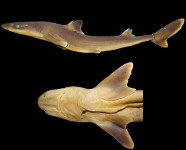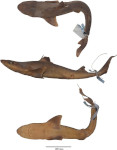Squalus mahia
Viana, Lisher & De Carvalho, 2017
Classification: Elasmobranchii Squaliformes Squalidae
Reference of the original description
Two new species of short-snouted dogfish sharks of the genus Squalus Linnaeus, 1758, from southern Africa (Chondrichthyes: Squaliformes: Squalidae). Marine Biodiversity, 48(4), 1787–1814
Two new species of short-snouted dogfish sharks of the genus Squalus Linnaeus, 1758, from southern Africa (Chondrichthyes: Squaliformes: Squalidae). Marine Biodiversity, 48(4), 1787–1814
Types
Squalus mahia
Holotype: SAIAB: 189449; Paratype: MNHN: 1987-1264; MZUSP: 120375; MZUSP: 120376; SAIAB: 25370; SAIAB: 203592 (formerly SAIAB 189449); SAIAB: 189450; SAIAB: 186419; SAIAB: 186461; ZMH: 26204; ZMH: 26205; ZMH: 26206; ZMH: 26207;
Squalus mahia
Holotype: SAIAB: 189449; Paratype: MNHN: 1987-1264; MZUSP: 120375; MZUSP: 120376; SAIAB: 25370; SAIAB: 203592 (formerly SAIAB 189449); SAIAB: 189450; SAIAB: 186419; SAIAB: 186461; ZMH: 26204; ZMH: 26205; ZMH: 26206; ZMH: 26207;
Description :
Citation: Squalus mahia Viana, Lisher & De Carvalho, 2017: In: Database of modern sharks, rays and chimaeras, www.shark-references.com, World Wide Web electronic publication, Version 12/2025
Please send your images of "Squalus mahia" to info@shark-references.com

Squalus mahia Viana, Lisher & De Carvalho, 2017, Paratype SAIAB 203592; Photo credit: Sarah Viana

Squalus mahia Viana, Lisher & De Carvalho, 2017, Paratype SAIAB 203592; Photo credit: Sarah Viana
Common names
 Malagasy skinny spurdog
Malagasy skinny spurdog
 Malagasy skinny spurdog
Malagasy skinny spurdog
Short Description
Original Diagnosis of VIANA, LISHER & DE CARVALHO, 2017 [25216]: A short-snouted dogfish from the western Indian Ocean that is distinguished from its congeners by having a slender body, narrow caudal fin with pointed dorsal and ventral caudal tips, and dermal denticles with markedly slender crowns. Squalus mahia sp. nov. is clearly distinct from its regional congeners S. acanthias, S. acutipinnis, Squalus cf. blainvillei, Squalus cf. mitsukurii, and the Australian species, S. megalops, by having a ventral caudal lobe mostly white with a black caudal blotch near lower caudal origin. It can also be differentiated from S. megalops by the following: more elongate first dorsal fin spine, its length 4.9% (4.2–5.1%) TL and corresponding to 0.6 (0.5–0.7) times the height of first dorsal fin in adult specimens (vs. 2.7–3.7% TL, 0.3–0.4 times in adults of S. megalops); dorsal fins slender and upright (vs. dorsal fins wide and low for S. megalops); postventral caudal margins not uniformly white (vs. uniformly white in S. megalops). Squalus mahia sp. nov. differs from S. brevirostris and S. acanthias by its greater preoral length (its length 9.5–11.1% TL vs. 8.5–9.1% TL for S. brevirostris and vs. 8.3–9.2% TL for S. acanthias). It is distinguished from S. brevirostris and S. crassispinus by the thickness of its first dorsal fin spine, base length 0.8–1.0% TL in adults (vs. 0.5– 0.7% TL for S. brevirostris and vs. 1.1–1.3% TL for S. crassispinus). Adults of Squalus mahia sp. nov. are distinct from those of S. acanthias and S. crassispinus by its first dorsal fin anterior margin length 10.5–12.2% TL (vs. 6.8– 9.8% TL for S. acanthias and vs. 12.6–12.9% TL for S. crassispinus). It is also separated from S. acanthias and Squalus margaretsmithae sp. nov. by its greater prespiracular length (12.4–13.7% TL vs. 10.7–12.0% TL for S. acanthias and vs. 11.5–12.3% TL for Squalus margaretsmithae sp. nov.). Squalus mahia sp. nov. can be separated from S. chloroculus, S. edmundsi, S. lalannei, S. mitsukurii, S. montalbani, and S. nasutus by smaller snout with prenarial length shorter than distance from nostril to upper labial furrow, and unicuspid and lanceolate dermal denticles (vs. prenarial length greater than distance from nostril to upper labial furrow, and tricuspid and rhomboid dermal denticles).
Original Diagnosis of VIANA, LISHER & DE CARVALHO, 2017 [25216]: A short-snouted dogfish from the western Indian Ocean that is distinguished from its congeners by having a slender body, narrow caudal fin with pointed dorsal and ventral caudal tips, and dermal denticles with markedly slender crowns. Squalus mahia sp. nov. is clearly distinct from its regional congeners S. acanthias, S. acutipinnis, Squalus cf. blainvillei, Squalus cf. mitsukurii, and the Australian species, S. megalops, by having a ventral caudal lobe mostly white with a black caudal blotch near lower caudal origin. It can also be differentiated from S. megalops by the following: more elongate first dorsal fin spine, its length 4.9% (4.2–5.1%) TL and corresponding to 0.6 (0.5–0.7) times the height of first dorsal fin in adult specimens (vs. 2.7–3.7% TL, 0.3–0.4 times in adults of S. megalops); dorsal fins slender and upright (vs. dorsal fins wide and low for S. megalops); postventral caudal margins not uniformly white (vs. uniformly white in S. megalops). Squalus mahia sp. nov. differs from S. brevirostris and S. acanthias by its greater preoral length (its length 9.5–11.1% TL vs. 8.5–9.1% TL for S. brevirostris and vs. 8.3–9.2% TL for S. acanthias). It is distinguished from S. brevirostris and S. crassispinus by the thickness of its first dorsal fin spine, base length 0.8–1.0% TL in adults (vs. 0.5– 0.7% TL for S. brevirostris and vs. 1.1–1.3% TL for S. crassispinus). Adults of Squalus mahia sp. nov. are distinct from those of S. acanthias and S. crassispinus by its first dorsal fin anterior margin length 10.5–12.2% TL (vs. 6.8– 9.8% TL for S. acanthias and vs. 12.6–12.9% TL for S. crassispinus). It is also separated from S. acanthias and Squalus margaretsmithae sp. nov. by its greater prespiracular length (12.4–13.7% TL vs. 10.7–12.0% TL for S. acanthias and vs. 11.5–12.3% TL for Squalus margaretsmithae sp. nov.). Squalus mahia sp. nov. can be separated from S. chloroculus, S. edmundsi, S. lalannei, S. mitsukurii, S. montalbani, and S. nasutus by smaller snout with prenarial length shorter than distance from nostril to upper labial furrow, and unicuspid and lanceolate dermal denticles (vs. prenarial length greater than distance from nostril to upper labial furrow, and tricuspid and rhomboid dermal denticles).
Distribution
western Indian Ocean from Socotra Islands and northern Madagascar to Algoa Bay, Eastern Cape in South Africa [25216] Source: www.gbif.org
western Indian Ocean from Socotra Islands and northern Madagascar to Algoa Bay, Eastern Cape in South Africa [25216] Source: www.gbif.org
Dentition
Upper teeth with 13 (12–13) rows and lower teeth with 10 (10–11) rows. Two series of functional teeth in upper and lower jaws in holotype, and two to three tooth series in paratypes. Teeth similar in both jaws, with upper teeth smaller than lower teeth; teeth alternating, labiallingually flattened and wide at crown; teeth unicuspid with cusp small, oblique and thinner on upper teeth than lower teeth; mesial cutting edge almost straight; mesial heel pointed and distal heel rounded; apron slim and shorter on upper teeth than lower teeth [25216]
Upper teeth with 13 (12–13) rows and lower teeth with 10 (10–11) rows. Two series of functional teeth in upper and lower jaws in holotype, and two to three tooth series in paratypes. Teeth similar in both jaws, with upper teeth smaller than lower teeth; teeth alternating, labiallingually flattened and wide at crown; teeth unicuspid with cusp small, oblique and thinner on upper teeth than lower teeth; mesial cutting edge almost straight; mesial heel pointed and distal heel rounded; apron slim and shorter on upper teeth than lower teeth [25216]
Remarks
shark-references Species-ID=14877;
shark-references Species-ID=14877;


















